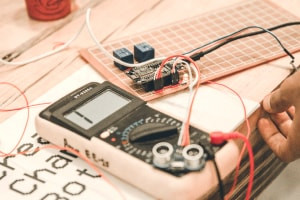In this course, you will learn about the interconnection of the electrical circuits, as well as mesh and nodal analysis of various electrical circuits. An introduction to network theorems, linearity properties, as well as the concept of duality, and the maximum power transfer theorem will also be covered in this course. Then, the course will teach you about the reciprocity theorem, compensation theorem, as well as the various ways to excite first-order circuits. You will also learn about singularity functions, and how to find the initial and final values of a second-order circuit.
Then in this course, you will learn about the properties of RLC circuits, the definition and properties of the Laplace transform, as well as carrying out inverse Laplace transforms. How to carry out circuit analysis using Laplace transform, the graphical approach to evaluating the convolution integral, as well as an introduction to a two-port network in a circuit will also be covered in this course. Then, the course will teach you about the concept of phasors and its application in AC circuit analysis, as well as an introduction to three-phase circuits and the phase sequence of three-phase voltages.
You will then learn about Mason's rule, and first-order differential equations, as well as the transfer function of multivariable systems, and the relationship between state equations and transfer functions. Lastly, the course will teach you about the characteristics equation from a differential equation, as well as the modelling of the mechanical and electrical system, and introduce you to the concept of rotational motion. Begin this course now to understand the fundamentals of electrical circuits and how to carry out various circuit analysis on electrical circuits.
What You Will Learn In This Free Course
View All Learning Outcomes View Less All Alison courses are free to enrol, study, and complete. To successfully complete this Diploma course and become an Alison Graduate, you need to achieve 80% or higher in each course assessment.
Once you have completed this Diploma course, you have the option to acquire an official Diploma, which is a great way to share your achievement with the world.
Your Alison certificate is:
- Ideal for sharing with potential employers.
- Great for your CV, professional social media profiles, and job applications.
- An indication of your commitment to continuously learn, upskill, and achieve high results.
- An incentive for you to continue empowering yourself through lifelong learning.
Alison offers 2 types of Diploma for completed Diploma courses:
- Digital Diploma: a downloadable Diploma in PDF format immediately available to you when you complete your purchase.
- Physical Diploma: a physical version of your officially branded and security-marked Diploma
All Diplomas are available to purchase through the Alison Shop. For more information on purchasing Alison Diploma, please visit our FAQs. If you decide not to purchase your Alison Diploma, you can still demonstrate your achievement by sharing your Learner Record or Learner Achievement Verification, both of which are accessible from your Account Settings.











 Avg. Hours
Avg. Hours  Contains Video
Contains Video  CPD Accredited
CPD Accredited 
 Total XP:
Total XP: 
 Knowledge & Skills You Will Learn
Knowledge & Skills You Will Learn 






